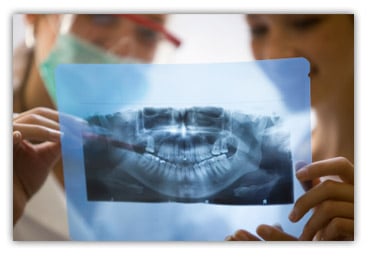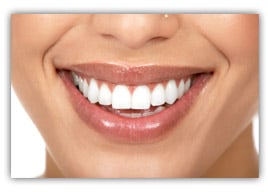Dental inlays and onlays are a dental procedure that is used to restore a decayed or damaged tooth to its original condition and can actually strengthen it.
They are a more conservative approach than a dental crown because they don’t involve the removal of healthy tooth structure.
For this reason, inlays and onlays are considered a minimally invasive cosmetic dentistry treatment and for many dentists and patients is a much better choice.
A crown, although not a bad procedure, involves the removal of more healthy tooth structure than needed and can increase the risk of tooth fracture and the need for a root canal treatment.

Inlays and onlays are fabricated in a dental lab and are then fitted and bonded to the damaged tooth by the dentist.
This type of restoration is called an indirect filling because unlike a traditional dental filling they are not molded into place during your dental visit.
What is the Difference Between an Inlay & Onlay?
Both inlays and onlays are pre-formed in a lab before being bonded to the damaged or decayed tooth.
The difference of use depends on the amount of tooth structure that has been lost to wear or decay. Your dentist will help you decide which is most appropriate for you.
An inlay fits within the grooves that are within the cusps of your teeth. An onlay, the larger of the two, fits within the grooves but wraps up and over the cusps covering more of the tooth’s surface.
An onlay is used when the damage is more extensive and the restoration covers the entire chewing surface including one or more tooth cusps.
The Inlay/Onlay Procedure

The procedure to place an inlay or onlay is basically the same and both require two dental visits unless your dentist has an in-office milling unit (See CAD/CAM Dentistry).
The first dental visit will involve the preparation of the tooth which includes the removal of the decayed or damaged portion. Because the procedure is conservative, the dentist will only remove as little tooth structure as possible to restore your tooth.
The area is numbed by a local anesthetic before being removed by a drill, dental laser or air-abrasion device.
After the decay and damage has been removed a mold of the tooth is taken and sent to the dental lab.
If your dentist has a milling unit in their office they can avoid the use of a temporary restoration. A temporary restoration is placed on the tooth until the inlay or onlay comes back from the lab.
Patients should consider looking for a dentist who can provide a single visit restoration as the time it takes a dental lab to fabricate the inlay or onlay can vary.
The single visit restorations are typically made by a machine such as the CEREC that enables the dentist to make porcelain crowns and inlays/onlays quickly and bond them in a single appointment.
Inlays and onlays can also be made from gold or resin materials which each have their own advantages. Gold has often been considered the strongest option although is not the most esthetic. You can discuss with your dentist what they think is the best option for you.
The permanent restoration involves the cleaning of the tooth to prepare for the new inlay or onlay. The inlay or onlay will be placed to ensure a correct fit before it is bonded to the tooth.
If the fit doesn’t interfere with the patient’s bite, it is permanently attached to the tooth using special cement or bonding then polished for appearance.
How Much do Inlays & Onlays Cost?
Most dental insurance plans will cover some to all of the costs associated with the inlay and onlay procedure because these treatments are considered restorative. The prices are based on national averages.

National averages suggest that:
- Inlays can cost from $700 to $800
- Onlays can cost between $800 and $920
Other factors that might affect the cost of the procedure include:
- The location of the dentist’s office
- The training of the dentist
- Expense of the dental lab
- The amount of teeth that need restorations
- The material used to restore the tooth (Gold, Porcelain or Composite Resin)
- The location of the tooth and the size of the restoration
